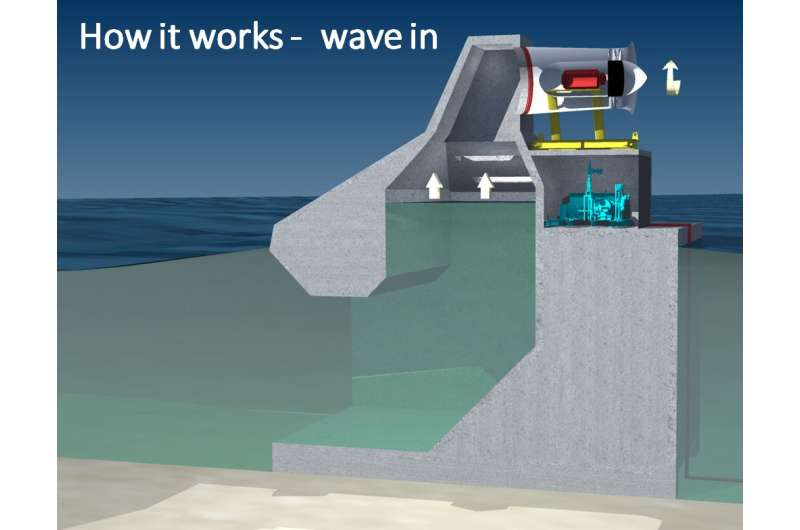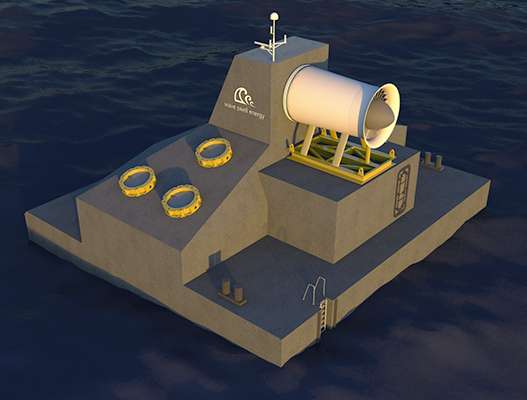May 14, 2017 weblog
Wave Swell Energy project to use its technology to harness power of waves

(Tech Xplore)—A system designed to harvest electricity from ocean waves is in the news.
Wave Swell Energy, an Australian company, has technology to convert the energy in ocean waves into clean, emissions-free electricity. It can be transmitted to shore and into the grid. It could also be used to power an onboard or shoreline located desalination facility.
"The latest technology is an extension of the oscillating water column (OWC), the most established concept in wave energy," said the company.
The news is that Wave Swell Energy is developing a 1 MW wave energy project intended for ocean installation off the west coast of King Island, between Tasmania and the Australian mainland.
New Atlas said a full-size unit is due to be up and running off King Island by mid-2018.
What is this device like?
"The beauty of the Wave Swell Energy technology is you have a very large and a very strong and robust concrete gravity structure—a bit like a rocky outcrop," said Associate Professor Gregor Macfarlane from the Australian Maritime College, in abc.net.au.
"The only part of the WSE device that is underwater is the concrete structure," said the company.
Many other wave-energy devices operate underwater, with exposure to the corrosive and damaging effects of saltwater and associated difficulties to maintain or repair.
Both turbine and generator in this device are above the waterline, meaning there is less maintenance. What is more, servicing can be carried out without the need for scuba equipment.
The devices measure 20 meters by 20 meters and are 18 meters tall. Of this, 8 meters projects above the waterline.
Why the King Island area? abc.net.au said King Island was already a renewable energy showpiece and boasts Australia's largest battery storage facility.
King Island has an excellent wave climate. The device can step in at the times when there is not enough wind and sun to produce the power required.

As New Atlas said, "waves are intermittent, but when it's combined with the solar and wind infrastructure already in place on King Island, the system can help patch some holes in the energy production."
CEO Tom Denniss said that it will enable them run the whole island completely off renewables for longer than they've done before.
The company mission is to demonstrate the ability of the company's technology, when installed at large scale, to produce electrical energy at a cost comparable to that of new coal-fired power plants.
The expected cost of energy production using WSE technology is 10 cents per kilowatt hour, said the company, comparable with new coal power. "This cost will fall further in coming years."
(New Atlas explained that the company claims its system should be able to produce electricity for a cost of about AU$0.10 (US$0.07) per kWh, which is roughly on par with coal.)
The Australian Maritime College, part of the University of Tasmania, tested Wave Sense technology and confirmed it produces 60% more power than comparable wave-energy technologies.
New Atlas on Friday spoke to Dr. Tom Denniss, the CEO of Wave Swell Energy. He elaborated on "artificial blowhole."
He said it's also "like a cavern that's open underneath the water, sealed at the top except for some valves and a turbine. What that means is that as the wave passes by the structure, water will flow into the cavern and rise inside. That displaces the air above, which gets vented out through a series of valves, and then when the wave starts to recede, those valves close. So the water wants to fall, and that creates a partial vacuum inside the chamber, and it sucks air back through past our turbine, and that's what generates the electricity."
The company talks up the system advantages and these include protection from corrosion and unit design life.
Exposed steel work will be of a marine grade and protected from corrosion for the length of the unit's life, according to the company, with each unit having a nominal design life of 25 years, "although it is expected they will last a lot longer than that."
The company said "wave energy is the most predictable source of renewable energy. While energy production from wind and solar can be intermittent and unpredictable, we are able to calculate wave height and intensity up to a week ahead. This is useful when the WSE generator is used to complement an existing fossil-fuel energy supply, so that wave energy is considered complementary baseline power."
At the same time, the company avoids perceptions of being the only renewable act in town.
"No single source of renewable power will replace coal. While coal will be phased out over the coming years and decades, it will be a combination of wave, wind, solar, tidal, geothermal, and other renewable sources which replace coal and, eventually, gas. Whichever source provides the best economics for that specific region will be the one that is favoured. In many places the most commercially viable option will be the WSE wave energy technology."
New Atlas said that the system's peak output is rated at 1 MW, with an operating average of about 470 kW.
More information: waveswellenergy.com.au/technology/
© 2017 Tech Xplore


















